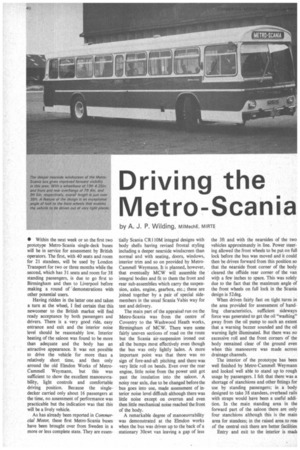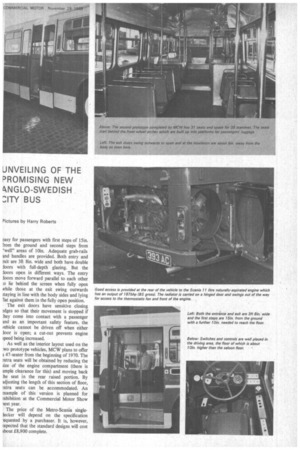Driving the Metro-Scania
Page 42

Page 43

If you've noticed an error in this article please click here to report it so we can fix it.
by A. J. P. Wilding, MIMechE, MIRTE
• Within the next week or so the first two prototype Metro-Scania .single-deck buses will be in service for assessment by British operators. The first, with 40 seats and room for 21 standees, will be used by London Transport for two or three months while the second, which has 31 seats and room for 38 standing passengers, is due to go first to Birmingham and then to Liverpool before making a round of 'demonstrations with other potential users.
Having ridden in the latter one and taken a turn at the wheel, I feel certain that this newcomer to the British market will find ready acceptance by both passengers and drivers. There is a very good ride, easy entrance and exit and the interior noise level should be reasonably low. Interior heating of the saloon was found to be more than adequate and the body has an attractive appearance. It was not possible to drive the vehicle for more than a relatively short time, and then only around the old Elmdon Works of MetroCammell Weymann, but this was sufficient to show the excellent manoeuvrability, light controls and comfortable driving position. Because the singledecker carried only about 16 passengers at the time, no assessment of performance was practicable but the indication was that this will be a lively vehicle.
As has already been reported in Commercial Motor, these first Metro-Scania buses have been brought over from Sweden in a more or less complete state. They are essen
daily Scalia CR110M integral designs with body shells having revised frontal styling including a deeper nearside windscreen than normal and with seating, doors, windows, interior trim and so on provided by MetroCaramel! Weymann, It is planned, however, that eventually MCW will assemble the integral bodies and fit to them the front and -rear sub-assemblies which carry the suspension, axles, engine, gearbox, etc.; these are joined together by a pair of special sidemembers in the usual Scania Vabis way for test and delivery.
The main part of the appraisal run on the Metro-Scania was from the centre of Coventry to the Washwood Heath works, Birmingham of MCW. There were some fairly uneven sections of road on the route but the Scania air-suspension ironed out all the bumps most effectively even though the bus was only lightly laden. A more important point was that there was no sign of fore-and-aft pitching and there was .very little roll on bends. Even over the rear engine, little noise from the power unit got past the insulation into the saloon. A noisy rear axle, due to be changed before the bus goes into use, made assessment of interior noise level difficult although there was little noise except on overrun and even then little mechanical noise reached the front of the body.
A remarkable degree of manoeuvrability was demonstrated at the Elmdon works when the bus was driven up to the back of a stationary 30cwt van leaving a gap of less the 3ft and with the nearsides of the two vehicles approximately in line. Power steering allowed the front wheels to be put on full lock before the bus was moved and it could then be driven forward from this position so that the nearside front corner of the body cleared the offside rear corner of the van witjt a few inches to spare. This was solely due to the fact that the maximum angle of the front wheels on full lock in the Scania design is 52deg.
When driven fairly fast on tight turns in the area provided for assessment of handling characteristics, sufficient sideways force was generated to get the oil "washing" away from the oil pump to such an extent that a warning buzzer sounded and the oil warning light illuminated. But there was no excessive roll and the front corners of the body remained clear of the ground even when this manoeuvre was made across drainage channels.
The interior of the prototype has been well finished by Metro-Cammell Weymann and looked well able to stand up to rough usage by passengers. I felt that there was a shortage of stanchions and other fittings for use by standing passengers; in a body designed to take 38 standees, overhead rails with straps would have been a useful addition. In the main standing area in the forward part of the saloon there are only four stanchions although this is the main area for standees; in the raised area to real of the central exit there are better facilities Entry and exit to the interior is madt
....asy for passengers with first steps of 15in. 'rom the ground and second steps from 'wellareas of Win. Adequate grab-rails and handles are provided. Both entry and .txit are 3ft 8in. wide and both have double Joors with full-depth glazing. But the Joors open in different ways. The entry loors move forward parallel to each other .o lie behind the screen when fully open while those at the exit swing outwards ;taying in line with the body sides and lying 'fat against them in the fully open position.
The exit doors have sensitive closing !dges so that their movement is stopped if hey come into contact with a passenger Ind as an important safety feature, the iehicle cannot be driven off when either Joor is open; a cut-out prevents engine ;peed being increased.
As well as the interior layout used on the wo prototype vehicles, MCW plans to offer 47-seater from the beginning of 1970. The extra seats will be obtained by reducing the ;ize of the engine compartment (there is 'mole clearance for this) and moving back he seat in the rear raised portion. By idjusting the length of this section of floor, :xtra seats can be accommodated. An :xample of this version is planned for mhibition at the Commercial Motor Show lext year.
The price of the Metro-Scania singleiecker will depend on the specification -equested by a purchaser. It is, however, :xpected that the standard designs will cost tbout £8,900 complete.
















































































































